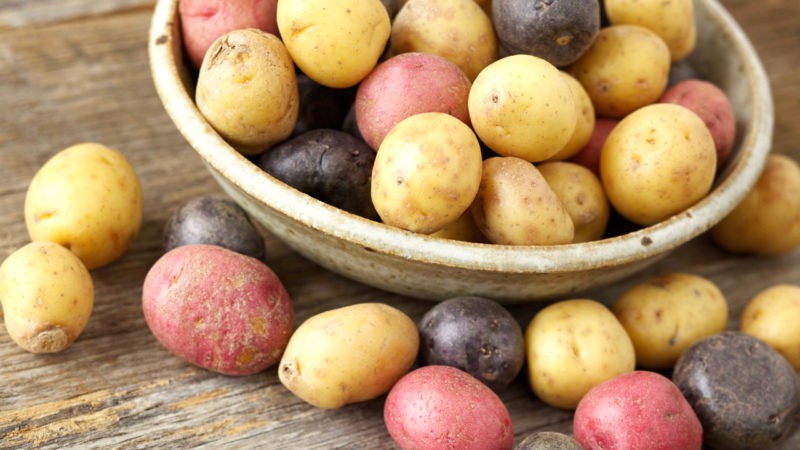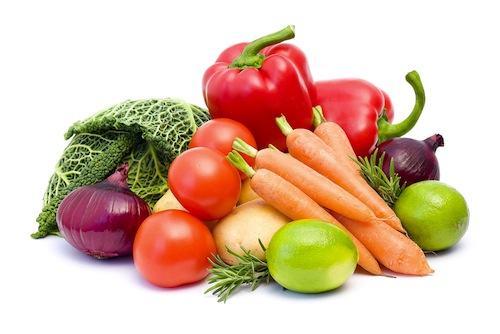Vegetables are beneficial for the human body in many ways due to their rich content of minerals, vitamins, antioxidants, fiber and many others. Vegetables can be divided into two different categories: starchy vegetables and non-starchy vegetables.
What Are Starchy Vegetables?
Starchy vegetables are high-carbohydrate plant foods that contain a rich energy source for man. Starch is a carbohydrate formed from the bonding of several glucose units, and is the most common form of stored energy from plants that is present in the human diet. Green plants produce starch and many staple foods like potatoes, rice, and corn contain large amounts of this organic compound.
Starch in vegetables are digested primarily by gastric amylase, an enzyme found in the gastrointestinal tract, and the digested starch is then stored in the cells to be used as energy. When eaten in large amounts, starchy vegetables can contribute to weight gain, because the stored energy which is not burned through exercise will be converted or transformed into fat, another form of stored energy. Eating a lot of starchy vegetables can also lead to increased levels of blood glucose which can increase one's risk for diabetes.
Tips When Consuming Starchy Vegetables
- Starchy vegetables are not necessarily bad foods, because they are filling, nutritious and healthy when consumed in proper amounts. Therefore, they should be eaten with much consideration on calorie intake to avoid gaining weight.
- Another factor to consider is that when cooking starchy vegetables to make them more easily digestible, their sugar content also becomes more easily absorbed by the body and can increase blood sugar levels more rapidly. Foods that can increase one's blood sugar levels rapidly are classified as high glycemic foods, and on a glycemic Index chart which rates foods from 0 to 100, starchy vegetables rate higher if they have less fiber and are more easily digestible. Depending on the type of vegetable and preparation, one-half to one cup of starchy vegetable provides about 15 grams of carbohydrates, 80 calories, and approximately 3 grams of protein.
List of Starchy Vegetables
 Most starchy vegetables are cooked before serving to enhance their digestibility and flavor. Although the vegetables mentioned in this list usually provide 15 grams of carbohydrates and about 80 calories per serving, cooking them with other ingredients such as butter or fat can increase these values. Keep in mind that half a cup of cooked vegetables is about the size of a cupped palm, while one cup is about as large as a fist. Common examples include:
Most starchy vegetables are cooked before serving to enhance their digestibility and flavor. Although the vegetables mentioned in this list usually provide 15 grams of carbohydrates and about 80 calories per serving, cooking them with other ingredients such as butter or fat can increase these values. Keep in mind that half a cup of cooked vegetables is about the size of a cupped palm, while one cup is about as large as a fist. Common examples include:
- Beans (1/2 c)
- Beets (1 c)
- Carrots (1 c)
- Corn (1/2 c or 1 medium-sized cob)
- Green Peas (1/2 c)
- Parsnips (1/2 c)
- Plantain (1/2 c)
- Pumpkin (1 c)
- Sweet Potatoes (1/2 c)
- Taro (1/2 c)
- White Potatoes (1 small piece, ½ c mashed, or 10-15 pieces of French fries)
- Winter Squash or butternut squash (1 c)
- Yams (1/2 c)
Other starchy vegetables include red potato, tomato, chickpeas (garbanzos), lentils, and plantains.
What Are Non-Starchy Vegetables?
On the other hand, there is also another type of vegetable: the non-starchy vegetables. These plant foods are nutrient-dense (having more vitamins, minerals, and antioxidants) but contain lower amounts of carbohydrate and energy compared to the starchy vegetables. These are vegetables that have more fiber and fewer calories than the starchy ones. A serving of one-half cup to one cup of non-starchy vegetables provides approximately 5 grams of carbohydrate and about 25 calories to the diet. Because of these, experts recommend eating 3-5 servings of non-starchy vegetables daily as part of a balanced diet for optimum health. They are especially recommended for people who are at risk for diabetes and heart disease, because they are nutrient-dense and can help lower blood sugar and cholesterol levels, owing to their high fiber and low calorie content.
List of Non-Starchy Vegetables
 Here is a list of common non-starchy vegetables which can be eaten in ½ cup to 1-cup servings, 3-5 times a day. These can be served fresh, cooked, or as canned products.
Here is a list of common non-starchy vegetables which can be eaten in ½ cup to 1-cup servings, 3-5 times a day. These can be served fresh, cooked, or as canned products.
- Alfalfa sprouts
- Artichoke
- Asparagus
- Avocado
- Amaranth or Chinese spinach
- Baby corn
- Bamboo shoots
- Bean sprouts
- Bok Choy
- Broccoli
- Brussels sprouts
- Cauliflower
- Celery
- Chayote
- Chicory
- Chinese cabbage
- Cucumber
- Daikon
- Eggplant
- Fennel
- Green onions
- Greens (collard, beet greens, dandelion, mustard, kale, turnip)
- Hearts of palm
- Herbs like thyme, parsley, basil, cilantro, and rosemary
- Jicama
- Leeks
- Lettuce
- Mushrooms
- Okra
- Onions
- Parsley
- Peppers (red, green, yellow, jalapeno, orange)
- Pumpkin
- Radishes
- Rhubarb
- Scallions
- Snow peas
- Spinach
- Sugar snap peas
- Swiss chard
- Turnips
- Water chestnuts
- Watercress
- Yard-long beans
- Zucchini
